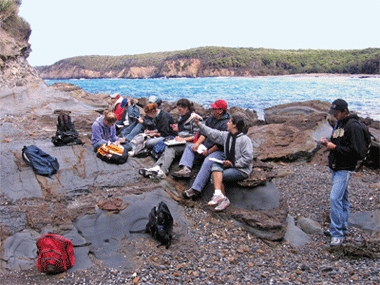Teaching and Training Program
undergraduate
 |
 |
 |
 |
GEMOC's teaching program aims to:• provide undergraduate and postgraduate students with a broad, integrative understanding of Earth architecture and processes, bridging the discipline boundaries of geology and geophysics • train undergraduate and postgraduate students in new conceptual approaches and the applications of advanced technology, including geochemical analysis techniques and the integrated field and laboratory use of geographic information systems (GIS) • develop international links in teaching programs (especially postgraduate) relevant to GEMOC's goals • develop formal tailored course work components at postgraduate level which also can be packaged for distance education delivery and as short courses available to the mining industry • enhance the pool of high quality geoscience graduates by restructuring academic programs to attract a new clientele |
HIGHLIGHTS 2006
Curriculum Development
- Once again our tailored problem-based learning (TPBL) units GEOS116 Marine Geoscience and GEOS115 Earth Dynamics, Materials and the Environment were well received by students. This format, which includes lectures, problem-based workshops and traditional skill-based practicals is designed to encourage the students to become more active learners and to develop a range of generic skills. The workshops are completed as group work projects and the students are required to produce scientific reports based on the results of their investigations. Generic skills developed include teamwork, problem-solving, critical thinking and written and verbal communication.
GEOS260 (Marine Depositional Environments) at the interface between old ones and recent ones.
- The Department of Earth and Planetary Sciences continues to deliver units using our tailored problem-based learning (TPBL) model. GEOS116 Marine Geoscience and GEOS115 Earth Dynamics, Materials and the Environment have successfully used this innovative technique for a number of years and in 2006, this was extended to GEOS260 Marine Depositional Environments. This format is designed to encourage the students to become more active learners and to develop a range of generic skills. Workshops are completed as group work projects and the students are required to produce scientific reports based on the results of their investigations. Generic skills developed include teamwork, problem-solving, critical thinking and written and verbal communication. A series of lectures provide background to each problem. GEOS260 is now divided into 4 modules: Methods of Analysis, Ocean Island Volcanoes, Passive Margin Processes, and Deep Marine Processes. The last three modules each have an assessable research project that combines technical skills training and production of a report or poster. The students attend a field trip to gather data for the project within the Passive Margin Processes module.
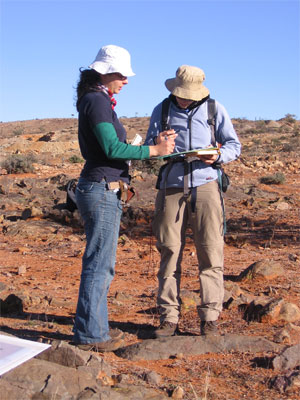
- GEOS307 Field Geology and Mapping was run in Broken Hill in 2006 in conjunction with Sydney University. The combined field trip allowed the students from both departments to interact and having staff from both departments provided a broad range of expertise.
- Our units continue to use the portable computer facility, computer packages and web interfaces in Earth and Planetary Sciences for content and skills delivery. Both geology and geophysics units incorporate packages used by industry into classroom and field teaching. A large number of our units now utilise “i-lecture” recordings, which provide MP3 recordings of our live lectures through a secure web interface. These are teamed with Microsoft PowerPoint slides to provide immediate access to lectures for distance education students and a flexible learning option for internal students.
GEOS307 Field Geology and Mapping, Broken Hill.

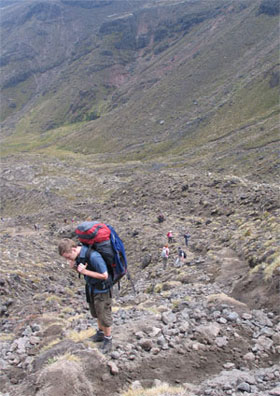
Students in GEOS373: Volcanic Geology Fieldwork, exploring
New Zealand’s scenic volcanic environments.

Geophysics teaching progress 2006
- The advanced geophysics stream in the Bachelor of Science degree continued
- The Bachelor of Technology in Exploration Geoscience has a Geophysics strand initiated in 1999, streamed from second year level (see flow sheet in Appendix 6).
- Use of an extensive pool of GPS units for undergraduate (and postgraduate) fieldwork continued.
- Extended implementation of new seismic, gravity GPS and resistivity equipment for student field projects in exploration, groundwater, environmental and engineering geophysics.
- Equipment upgrades funded by Macquarie University over the last five years have resulted in an excellent array of new instrumentation. Acquisitions include:
- GEOMETRICS G856 Proton Precession Magnetometer
- GEOSOFT, MODELVISION, EMVISION, ERMAPPER, SeisImager, Maxwell and Reflexw software was either purchased or upgraded
- ABEM SAS4000 Resistivity System and an ABEM LUND system
- ASHTECH Z-Xtreme Differential GPS system
- DUALEM Frequency Domain EM System
- MALA Ground Penetrating Radar (GPR)
Outcomes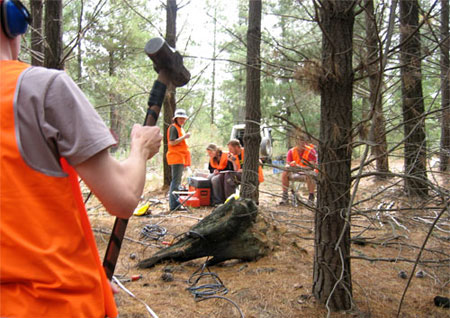
Our units continue to attract new clientele to the geosciences, many of whom go on to further studies in this area. However, this is within an environment of a contracting pool of science undergraduates. Despite this, GEMOC core units at 100 level have maintained enrolment levels and our units at 200 and 300 level have seen increases in numbers. Reorganisation of course structures and acquisition of teaching infrastructure (computers, high-technology instruments, GIS units) have increased the visibility of geoscience and have resulted in the presentation of geoscience with an interdisciplinary and innovative approach using state-of-the-art technology and concepts.
GEOS316 Exploration Geophysics students undertaking a seismic survey using a sledge hammer as a seismic source.
GEMOC honours
Nicole harb was awarded the University Medal for her 2006 honours work.
The following honours projects in GEMOC were completed 2006:
Nicole Harb: Fragmentation processes, depositional mechanisms and lithification of glassy fragmental rocks, Macquarie Island
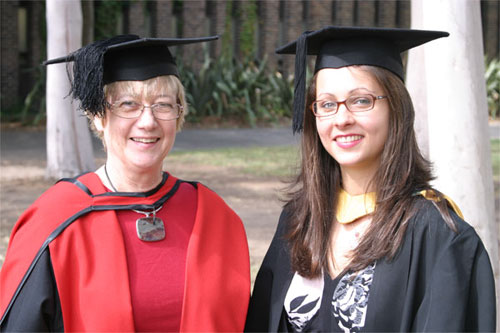
Sue O’Reilly and Nicole Harb at Nicole’s graduation in April.
The following honours projects are relevant to GEMOC in 2007:
Cara Danis: The 3D upper crustal structure of the Wongwibinda Complex, New England Fold Belt: a tilted block?
Peter Caffi: Fabric development and finite strain patterns in a metamorphic dome bounding shear zone, Dayman-Suckling Dome, Papuan Peninsula, Eastern PNG
Elizabeth Hoese: Investigation of Type 1 and Type 2 kimberlites from southern Africa
GEMOC postgraduate
 |
 |
 |
 |
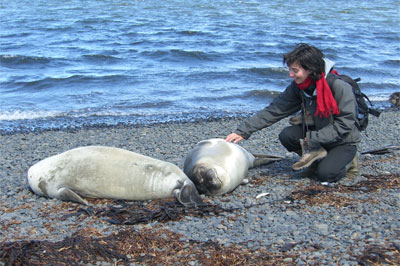 See advertisement for GEMOC postgraduate opportunities, Appendix 7.
See advertisement for GEMOC postgraduate opportunities, Appendix 7.
GEMOC’s active international exchange program continued, with Weiqiang Li from Nanjing University (China) commencing in early 2006. June Chevet, as a part of a co-tutelle program with the University of Jean Monnet (St Etienne, France) undertook fieldwork in Kerguelen; Yoann Gréau and Véronique le Roux will commence PhD co-tutelle programs with the University of Montpellier (France).
June Chevet getting to know the locals on Kerguelen (see June’s Research Highlight: "Building an oceanic plateau:...")
completed
Olivier Alard (PhD): Chalcophile and siderophile elements in the mantle: Geochemical characteristics and distribution; IPRS with MUIPRA stipend (graduated 2001)
Kari Anderson (PhD): Palaeozoic Eastern Gondwana: palaeomagnetic investigations of Queensland; IPRS with MUIPRA stipend (graduated 2003)
Sonja Aulbach (PhD): Evolution of the lithospheric mantle beneath the Slave Craton and Alberta Canada; IPRS with MUIPRA stipend (graduated 2004)
Elena Belousova (PhD): Zircon and apatite geochemistry: applications to petrology and mineral exploration; APA and sponsorship by Rio Tinto (graduated 2000)
Eloise Beyer (PhD): Evolution of the lithosphere beneath Tasmania and Western Norway; Field assistance from Ashton Mining (graduated 2003)
Rondi Davies (PhD): East Australian Diamonds: Characterisation and origin; Sponsored by Rio Tinto, Kennecott Canada (graduated 1999)
Guillaume Delpech (PhD): Trace-element and isotopic fingerprints in ultramafic xenoliths from the Kerguelen Archipelago (South Indian Ocean); Co-tutelle with University of Jean Monnet, IPRS with GEMOC stipend and EURODOC scholarship (graduated 2005)
Oliver Gaul (PhD): Composition of the lithospheric mantle beneath Australia; APAI collaborative with Stockdale Prospecting, CSIRO EM (graduated 2000)
Bin Guo (PhD): An integrated geophysical investigation of the Tamworth belt and its bounding faults; IPRS with MUIPRA stipend (graduated 2005)
Joanne McCarron (MSc): Mantle xenoliths from Queensland and South Australia (graduated 1997)
Bertrand Moine (PhD): The role of fluids in the genesis, segregation and crystallisation of intraplate oceanic mantle magmas: implications for crustal accretion; Co-tutelle with University of Jean Monnet (graduated 2000)
 Mark Pirlo (PhD): Australian groundwater geochemistry; applications to heat flow and exploration; APA and Queen’s Trust for Young Australians Award (graduated 2003)
Mark Pirlo (PhD): Australian groundwater geochemistry; applications to heat flow and exploration; APA and Queen’s Trust for Young Australians Award (graduated 2003)
Will Powell (PhD): Geochemically diverse domains in lithospheric mantle, eastern Australia; APA (graduated 2006)
Will Powell, Kelsie Dadd and Dick Flood at Will’s graduation.
Sonal Rege (PhD): Trace-element geochemistry of diamond; IPRS with iMURS scholarship (graduated 2006)
Stéphanie Touron (PhD): Geochemical fingerprints of mantle metasomatism beneath the Massif Central, France; IPRS with MURAACE scholarship (graduated 2006)
Esmé van Achterbergh (PhD): Geochemical fingerprints of mantle metasomatism (graduated 2005)
Shixin Yao (PhD): Chromite as a petrogenetic indicator in ultramafic rocks; Collaborative with Rio Tinto (graduated 2000)
Xu Xisheng (PhD): The lithospheric mantle beneath eastern China; Formal exchange PhD, Nanjing and Macquarie (graduated 2000)
current
Brad Bailey (PhD): Law Dome: Ice and crust mass balance studies (commenced 2004)
Jacques Batumike (PhD): The origin of kimberlites from the Kundelungu region (D.R. Congo) and the nature of the underlying lithospheric mantle; IPRS, iMURS (commenced 2005) (see Research Highlights)
Stephanie Carroll (PhD): The mechanisms and deep-crustal controls on continental rifting; RAACE (commenced 2005)
John Caulfield (PhD): Tofua volcano- Tonga Arc: Eruption history and timescales of magma chamber processes; iMURS (commenced 2006)
June Chevet (PhD): Gabbroic rocks from the Kerguelen Islands (Indian Ocean): a petrologic, geochemical and isotopic investigation of their origin; iMURS (commenced 2005) (see Research Highlights)
David Clark (PhD): Contributions to integrated magnetics - applications to the Earth Sciences (commenced 2006)
Steven Cooper (PhD): Diamonds and mantle-derived minerals, NW Australia and South Australia (commenced part time 2003)
Stephen Craven (PhD): The structural and metamorphic evolution of the Wongwibinda Complex, NSW, Australia (commenced 2006)
Heather Cunningham (PhD): A U-series isotope study of magma residence times, degassing and petrogenesis of Rabaul Caldera, Papua New Guinea; iMURS (commenced 2005)

Sue O’Reilly, Dave Apter (De Beers) and Alan Kobussen picking goodies from heavy-mineral concentrate at the Lace Mine, South Africa.
Alan Kobussen (PhD): Composition, structure, and evolution of the lithospheric mantle beneath Southern Africa; iMURS (commenced 2006) (see Research Highlights)
Weiqiang Li (PhD): Stable metal isotope geochemistry of the Cadia and Northparkes porphyry Cu-Au deposits; iMURS (commenced 2006)
Marek Locmelis (PhD): Understanding nickel deposits using platinum group element geochemistry (commenced 2006)
Kathleen McMahon (PhD): Fracturing and deformation along the Amery Ice Shelf: A seismic study (commenced 2004)
Luke Milan (PhD): The emplacement, pressure-temperature-time path and structural evolution of lower crustal gneisses in Fiordland, New Zealand (commenced 2004)
Valeria Murgulov (PhD): Lithosphere evolution and metallogeny in the Georgetown Inlier and adjacent Tasman Fold Belt, North Queensland, Australia; APA (commenced 2003, submitted Nov. 2006)
Nenad Nikolic (PhD): Evolution of crust-mantle systems near a young rift: NW Spitsbergen, Norway; iMURS (commenced 2004)
Ryan Portner (PhD): Spreading ridge sedimentation processes: a novel approach using Macquarie Island as a natural laboratory; iMURS (commenced 2006)
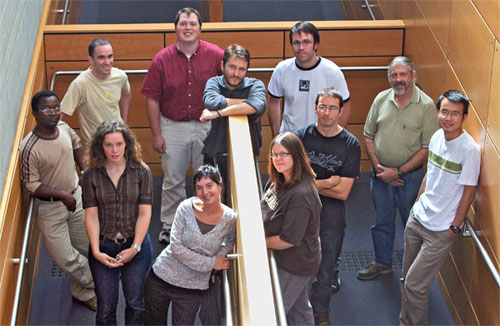
Some of GEMOC’s 2006/7 postgraduate students. Above: Jacques Batumike, John Caulfield, Alan Kobussen, Nenad Nikolic, Luke Milan, Stephen Craven and Weiqiang Li. Below: Véronique Le Roux, June Chevet, Cara Donnelly and Yoann Gréau.
commencing 2007
David Child (PhD): Characterisation of Actinide particles in the environment for nuclear safeguards using mass spectrometric techniques (part time)
Cara Donnelly (PhD): Mantle xenoliths, kimberlites and related rocks of the Kuruman Kimberlite Province, Kaapvaal Craton, South Africa; iMURS
Yoann Gréau (PhD): Elemental and isotopic fractionation of siderophile and chalcophile elements: A new perspective on eclogite origin; iMURS and Co-tutelle with Montpellier University. France
Véronique Le Roux (PhD): Refertilisation and isotopic variations (Sr, Nd, Hf) in the Lherz Massif (France); Eurodoc and Co-tutelle with Montpellier University, France (see Research Highlights)

 GEMOC ARC National Key Centre
GEMOC ARC National Key Centre